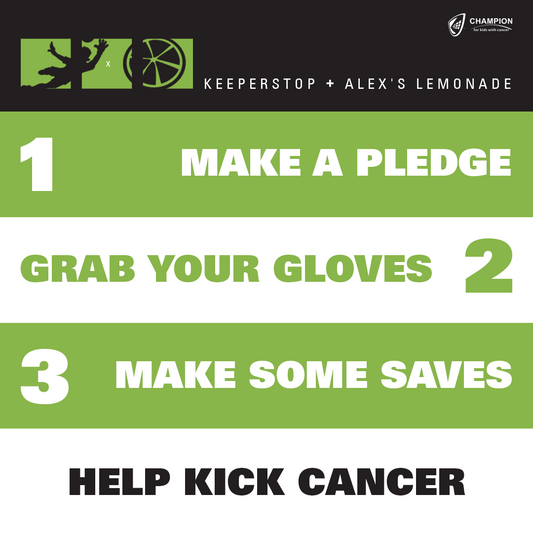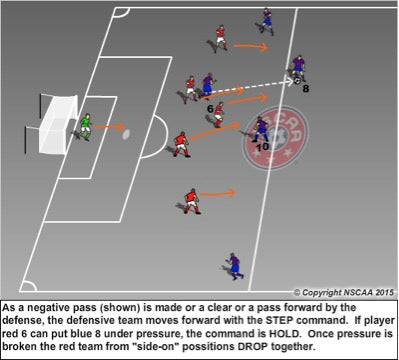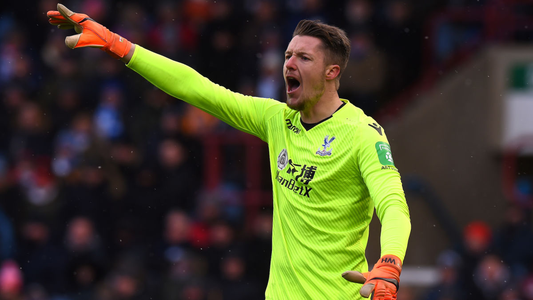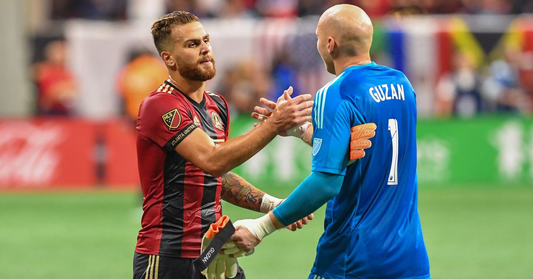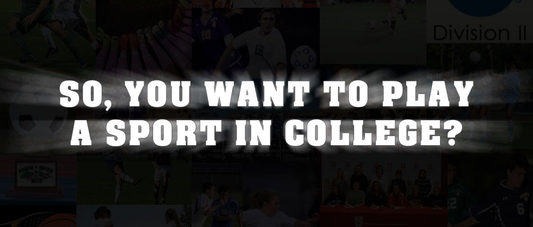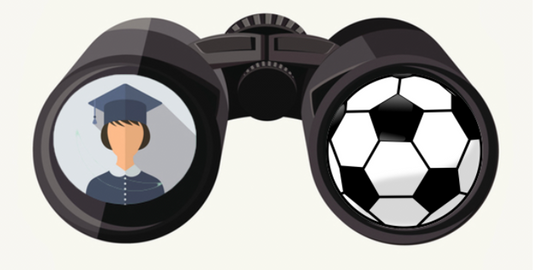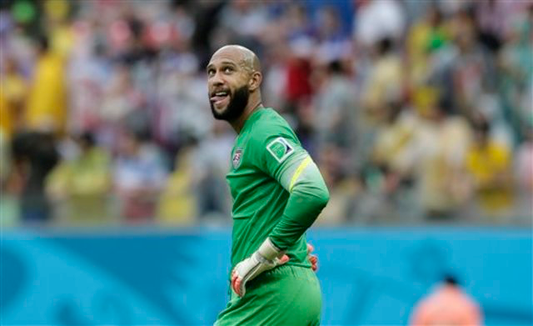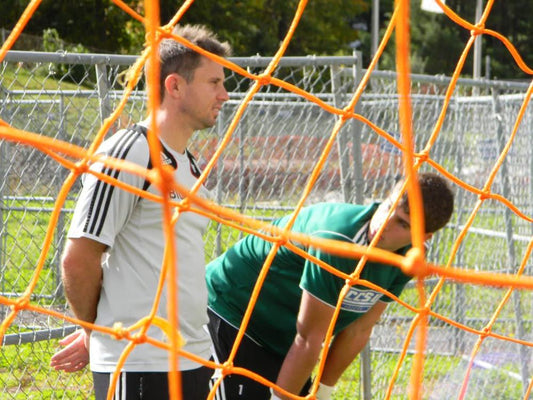Communication is a vital part of being a goalkeeper. You should act as the team general and keep your teammates organized and tactically aware of their surroundings. The ability to communicate effectively with your defense can stop shots and goals happening before theyt get anywhere near the penalty box. As a keeper, we should be using our view of the entire field to keep our team organized and stop attacks as early as possible.
Goalkeeper Communication
Goalkeepers Raising Money For Childhood Cancer Research
Alexs Lemonade Stand and Keeperstop partner for Champions Kick-It.org campaign.
Champions For Kids With Cancer: By Alex's Lemonade Stand Foundation
"Community Service while Goalkeepers And Field Players Play The Sport They love"
Goalkeepers and Field Players alike can register for free, track stats, upload and share photos. Their passion for scoring goals and goalkeeping, assists and breakaways, or PK saves can turn into life saving research dollars supported by friends and family. It is important to be a good athlete on the field but it is more important to be a great person off the field for your teammates and others in your community.
This initiative started with a small group of Football Field Goal Kickers. Their passion and iniatitive inspired others which raised over $200,000+. Athletes and young adults off all ages want to make a difference and help others. Champion For Kids With Cancer gives them the platform. This is an impactful way to play the sport an athlete loves while providing a valuable community service.
Alex Lemonade Stand Foundation has raised over $150 million for childhood cancer and funded 800 research projects. Champions For Kids with Cancer turns ever game and field into a Lemonade Stand. 1 in 285 will be diagnosed with some form of Pedriatric Cancer. ALSF is the best way to make a difference with a child that would like to get back on the field to save or score goals. .85 cents of evey 1.00 raised goes to support research projects and families in need.
Be a leader. Forward the KICK-IT.ORG campaign to your teammates, coaches, and friends playing other sports. Every quarter or dollar helps. Raise what you can. The most important aspects are you are involved, raising awareness, and trying to make a difference. Providing goalkeeper glove and equipment education is great but I really feel the soccer community and GK Union can make a difference. Contact paul@keeperstop.com with any questions on how to get involved or encourage your team..
Goalkeepers reading and communicating. Reading the space behind
In the modern game, the coordination between the back defenders, holding midfielder/s and goalkeeper is critically important. The modern game requires the back defenders to condense the space in the midfield by forward movements coupled with use of the off side law. This condensing of space serves to reduce the opponent’s ability to build their attack through midfield.
The challenge is as the space in the midfield is reduced, the space behind the defense is increased. It is imperative that the goalkeeper and defenders train and coordinate to cover the space behind. This training includes communication so that everyone is on the same page, exploring the physical capabilities of the keeper to cover space behind and, of course, the defenders and collective back defense reading the game. Specifically: read service; attacking runs, the quality of the runs and movements so that defenders eliminate attacking space behind their restraining line while the goalkeeper is trained to make good decisions and win some of that same space when necessary.
There are a number of different tactical approaches for the back defenders.
They can hold a very strict line, using the off-side law, being conscious of attacking players and runs but responding only to the ball and responding only AFTER the ball is played.
They can read the 1st attacker (head down or up), read service and drop BEFORE service based on pressure on the ball and quality of the runs from the attacking opponents
They can condense until the opponent has secured possession and initiated a probing attack and then drop into a sweeper system.
My philosophy of training my goalkeeper, back defenders and even holding midfielder/s is a combination of 1 and 2 above.
The first concepts I coach are the concepts of communication. I want my goalkeeper and defenders seeing, reading and communicating the same thing.
Whenever a ball is played negatively by the opponent (more than just a few yards) or cleared or played forward by our team, I want the key communicators (usually GK and central defender and maybe more) commanding the team to STEP! STEP!
If there is pressure on the ball when the opponent has the ball (midfield or attacking third), I want the key communicators, organizers to call out HOLD! HOLD! This means to stay in the condensed shape. The defenders, especially central defenders need to be quarter turned or side on when the team is holding a high line so they are ready to side-on sprint back into the exposed space.
If pressure is broken and the opponent can play forward, the command is DROP! DROP! The back defenders drop together and, the players are already positioned side-on so that sprinting to cover space is easier. If my defense is working properly there is a pulsating movement of condensing and expanding while the opponent has possession. This forward, backward adjusting movement causes challenges for the attacking forwards to time their runs to get in from passes being played in behind.
My teams don’t often just hold the line, especially if the opponent’s forward are fast. I want my GK and back defenders to adjust based on the movement of the ball, pressure on the ball and quality of opponent’s runs.
I train this using a simple GK – Back Four – Holding Midfielder organization such as this and add players for the attacking team as needed. The defensive team can’t intercept of tackle but just move and communicate to condense, expand and eliminate dangerous attacking spaces in front and behind the defensive restraining line.
Now, look at the next diagram. With no pressure on the blue #6. I still want the defense to STEP as the ball is passed back to that player, but, in my defensive scheme, they can’t just hold that position because without pressure the pass and run combination to attack the space behind the defense is too “on”. Therefore, the defensive red team must expand immediately after condensing to cover the space behind. I call this “automatic expansion” and every defender and GK understands and executes.
If the ball goes wide, then the rotation is as shown below with the outside back rotating towards the attacking player. This won’t happen every time as the outside back needs to make a tactical decision which is, can I put this player under pressure AS they are receiving the ball or should I hold my shape with the central defenders and allow the attack to progress and also allow a central teammate to slide out to defend the ball.
Now, I train breakdowns from both central and wide positions. The first key breakdown is when the holding midfield gets beat somewhere in the middle third. You must train the coordinated response from the remaining defense, which is to drop together and consolidate centrally until reaching the top of the ‘D’; then a center back can step out to play the ball. By dropping together, the defense again eliminates space behind and also ties in the goalkeeper when a through ball is made. A critical mistake with my defenders is when the breakdown occurs somewhere around midfield for one of the center backs to try to win the ball back immediately. If they fail, the counter attack is on full speed and the chance of giving up a very good scoring opportunity is much higher. The defense must retreat together and by doing so delay the attack, allow for other to re-catch up but also bring the goalkeeper into the play.
If there is a breakdown wide so that an outside back is beaten what is the defensive adjustments? The first is for the holding midfielder (#6) to drop back into a center back position as the center back slides out to become the 1st defender (defender on the ball). Another adjustment can be the weak side winger now having to urgently get back to cover the back post area as the other defenders slide over.
The best way to train these scenarios is to play offense vs defense but change the numbers…allow for breakdowns (player losing the ball, is out of the play for a 5 count) or any other restrictions that force defenders to communicate, and defensive rotations to fill gaps and solve breakdowns to take place.
Tony DiCicco in addition to being the Director of Goalkeeping for the NSCAA is the former Head Coach – USA Women: ’96 Olympic Gold; ’99 World Cup Championship; ’08 U20 World Cup Championship. DiCicco also is the Founder and Technical Director of SoccerPlus Goalkeeper School and FieldPlayer Academy. For information go to www.soccerplus.org or call 1-800-533-7371.
Communication to Establish a Presence on the Field
An understanding of the game is the foundation of the modern keepers ability to communicate and establish a presence on the field.
We want our keepers to communicate and have a presence on the field. While there are many components that help establish the personality and presence of a goalkeeper, one thing that is essential is the ability to communicate and direct play. At the foundation of the keepers ability to to do this is an understanding of what is and what needs to happen on the field, and the ability to communicate this to the team quickly and clearly. It is unfortunately the progressive building of the keepers full game understanding that is often neglected and the result is a goalkeeper who does not communicate effectively and whose presence does not fully develop.
One of the reasons that this foundation of understanding is often overlooked is due to the fact that at all levels of the game, goalkeepers frequently learn and train the technical aspects of the position during specialized position-specific training sessions away from the team. This attention and training, while essential, has limitations. Often while the keepers are off training, the team is learning the tactical components that they will utilize in games. When the keepers return to the team they are put into games where they are not only expected to make the save but to read and direct the game in front of them. Because the goalkeeper has not been with the team as they progress through tactical demands and expectations, he or she may not understand what the team is expected to do, or have the vocabulary to communicate adjustments. A coach may recognize this and, trying to be helpful, may tell the keeper what system that they will be playing, but that is not enough. If the keeper has only ever played four in the back with a stopper and sweeper and the team has just spent time learning a “flat” four the problem becomes obvious.
So the question becomes how to effectively train keepers in both the technical specifics of their position and develop their tactical understanding of the game. The coach that is able to do this effectively will ensure that the keeper becomes both a confident and constructive voice on the field. This voice does not develop overnight but, like the ability and understanding of their field player counterparts, comes over time and through progression.
Communication at the early stages of development can be as simple as calling “Keeper” when going for the ball. This sounds easy, after spending a water break with a team of any age or gender we all know that even the youngest players can talk. However, on the field, younger players may not have the confidence needed or do not want to appear “bossy” or “mean” to their teammates. If this is the case, getting a young keeper to give this basic command can be as simple as giving them permission to do so. Reassuring them that their teammates want to hear from them can go a long way in getting a young goalkeeper to begin to be vocal and communicate on the field.
Once a keeper is comfortable with basic commands, the next step is for him or her to begin to take an active role in directing the play immediately in front of them. This is easiest to teach in fairly predictable situations where variables are easier to identify and manage, for example during restarts. In these situations the communication expands to include the positioning of players on the field in relation to a stationary ball. Here the goalkeeper needs to understand what the team is expected to do defensively (set a wall, cover a post, a player, an area…) in a given situation. Establishing simple and consistent commands and expectations that both team and goalkeeper understand is the first priority. The young goalkeeper will gain experience and confidence during training sessions devoted to these situations when the play is stopped and the commands relatively predictable. As the keeper begins to communicate in these situations, his or her voice and presence will begin to develop in other situations. With this development the keeper starts to become an integrated part of the team on the field.
Unfortunately, too often a keeper may be able to communicate and take charge in the box or on a set piece, but once the ball is out of immediate danger he or she does not develop much past this and essentially becomes a bookend to the play. At best the goalkeeper may move with the play, but say nothing, and at worst he or she may stand firmly planted somewhere in the 18 and watch with limited or no understanding of the play that is unfolding on the field. Not only is the latter not helpful to the team, but it puts the keeper in a position where he or she will likely be out of position when called upon to be involved in the play. It is therefore essential that the keeper continues to develop past this.
The keeper must now progress from reacting to an immediate or fixed situation, to an understanding of and ability to communicate during the flow of the play. The keeper is now expected to identify and understand situations as they develop and communicate proactively to direct the play in response. It is here that keepers often get stuck, not from a lack of desire, but rather it is a lack of understanding and vocabulary that prevents their progression. Development of this ability is therefore twofold.
The goalkeeper must both understand the demands of the game and be able to articulate this understanding in a clear and concise manner that the team understands. This is most easily done when the keepers foundation of individual and team tactics is laid from the youngest age on in conjunction with the team. Just as a defender must have an understanding of the role of the 1st defender before he or she can be expected to comprehend team defensive tactics, a keepers understanding must similarly be developed. This understanding can be facilitated by making sure that the keeper is actively involved in team training when tactical components are first addressed.
When moved to a higher level of play, a good reactionary keeper may not have the foundation necessary to understand what is happening on the field. When it is not possible to train the keeper through this progression with the team, without losing individual keeper specific training time, it is essential that it is taught to the keeper once he or she returns the team. While learning alongside the team is best, one way to provide a tactical crash course as it were is to have a coach stand behind the keeper during training and talk through what they are seeing on the field. Take for example a collegiate keeper I worked with. Her performance in goal was above average, but outside of saying “Keeper” and “Away” she was essentially mute. Her positioning was good, she had had solid technical training, was confident in her abilities and had a good relationship with her teammates. In my mind there was no reason she should not be communicating on the field. At first I chalked her silence up to freshman jitters, but it soon became clear that while she understood the position and could read what was happening on the field, and react appropriately, she had no idea how to articulate this understanding to her teammates. I spent several sessions standing behind her in goal during training. During this time I did not give her direction, but rather acted as her voice directing the team. As we did this she began to learn the vocabulary needed to articulate what she saw on the field and began to communicate more. The more she said the less I did until my talking stopped and she took charge. Had she been taught from an early age not only how to read and react to what she saw, but been given the vocabulary to communicate this to her teammates, she would have developed her presence on the field much sooner.
Like the keeper mentioned above, many keepers can tell you what they do not want to see, but do not fully understand how to make positional adjustments or communicate these adjustments to their teammates. Whether it is because they were off training separately, or thrown in goal with little direction as the team covered tactics, the result is the same - a keeper with limited ability to effectively communicate with the team. A keeper who understands the bigger picture of the game and communicates this effectively will establish a presence on the field and be able to not only manage and avoid dangerous situations defensively, but become an integral part of a team’s ability to initiate and take advantage of attacking opportunities. It is therefore essential, in order to develop goalkeepers who are vocal and have a presence on the field that, from the youngest age on, the goalkeepers understanding of the game is developed alongside that of their teammates.
Sarah Dwyer-Shick
Communication between Goalkeepers and Field Players
At Williams Sport Training in New Jersey you hear a lot about the physical nature of defending & goalkeeping. In this article you will read about the importance of communication between the goalkeeper & field players. Communication is essential to defend effectively in the game of soccer. Coordination amongst your backline limits shots on goal and makes things difficult for the opposition. Organized teams know when to pass players off and how to collectively cut down angles and passing lanes for opposing players. Open communication also keeps the goalkeeper focused in a game where they aren't seeing much of the ball and in games where there is lots of action.
You must understand as a keeper how important your role is. Your presence and attitude determines how your defenders perform as well as decisions attackers will make with regards to shooting on goal. If your backline doesn’t have confidence in you and doesn’t truly understand what you want from them they will defend hesitantly which in turn will cast doubt about you in your coach’s mind. Attackers will think twice before challenging a loose ball in your box if you give an aggressive demeanor. They will also think twice about shooting a ball from distance and instead look to pass and get closer to goal for an easier chance to score. More passes in your defensive third gives your players more time to get behind the ball.
During the course of a 90-minute match your side may dominate the opposition, however it take only one encounter to change the outcome of a dominant performance. As a keeper your attitude and mental focus for the entire match can determine the outcome of tight games. By communicating with your defenders a goalkeeper can keep the back line organized without being too high and minimize the chance of a defender keeping a player onside by being too deep. Awareness on the defensive side of the ball can win you many games. It is hard for defenders to be aware of everything happening around them for 90 minutes because they are focusing on the ball. Defenders are often positioning themselves so they can see the ball & the run of their mark. Being tactically sound is difficult; it takes experience and usually someone with a watchful eye. You must understand that being positioned to defend the man & the space behind you is a skill. A tactician is hard to come by at the youth level. Coaching staffs look to keepers to keep that watchful eye on the backline. Oppositions are always looking for gaps within the back line or a cheeky ball to play over the top. In the modern game, the speed of play changes quickly and often so defenders need help with perfect positioning to avoid getting diced by the killer ball. Goalkeepers are responsible for loose marks and free runners.
As a keeper being able to see the whole field is something that you can’t take for granted. Constantly tell your players what you want from them. Tell them what you see, even if they see it too. Your voice will serve as a checklist in your defender’s mind. This will give them confidence and look to make sure their fellow defenders are in check. Goalkeepers can always see the play develop and can direct which way a defender should push the opposition or step to the ball. Goalkeepers talking their players through the passing off of attackers will put the backline into positions where they can challenge every opportunity in and around the box. Talk to your defenders in training, just before a game, during halftime, and during stoppages in play. Keep them focused and address what you want in the future in case there is a scenario where you can’t communicate or your communication turned into a misunderstanding.
For set-pieces it is important for a goalkeeper to know everyone’s responsibilities. During training discuss the option of man marking or zonal marking. Designate responsibilities and be accountable. Know which positions his defenders are going to be taking up and which players they are marking. Know who will be on the wall. Putting someone on the post for corner kicks may save you every now and then. Communication is particularly vital at corner kicks, and vocal directions will help avoid miscommunication that leads to unorganized defending or an injury due to a collision.
Talking to your defender as he/she is getting backed down will help them understand what direction you want them forced. During a counter you may have to become a sweeper keeper. Direct your players clearly on which way to push the attack. Confidence is key here because in certain situations you may need to call upon your defender to direct the opposition towards goal in order to stop a better clear cut goal scoring opportunity. A clear opportunity in this circumstance is a square ball across the six-yard box or around the penalty area that leads to an easy tap-in. You can’t hesitate in these situations. You must communicate clearly and quickly to shun the counter. You must have trust in yourself to be able to step off your line and challenge aggressively, but also wisely.
Keepers must also understand this factor in communication: the tone of your voice. The way we communicate to our fellow teammates is important at the youth level. The way you address your players depends on the scenario. You must ask yourself:
1. What is the situation?
2. Is there a sense of urgency?
3. Who am I communicating to?
Keepers must know everyone’s personality. Goalkeepers need to be psychologists and understand the personalities of all their teammates to properly communicate with them. You should know when to be encouraging and when to be demanding. You can be both at the same time during certain scenarios, but choose wisely so as not to alienate your teammates.
After reading this article the biggest thing for keepers to take away from this is accountability. Keepers should act as surgeons to the game. Be tactically prepared for anything to happen. Keepers should have a check-list in their mind for every possible game scenario. Keepers should have a check-list for throw-ins, corners, set-pieces, penalties, and turnovers. Make sure you know what you want in training. Make sure you’re aware of opposing players who can thread dangerous passes and score from distance. Urge your players to always challenge these opponents. Avoid preventable goals and soft goal scoring opportunities with your communication. Be accountable, be a leader and the backbone of your defense.
About Mark Williams: Mark Williams has been a strength and conditioning coach for over 10 years during which time he has worked with athletes in every sport. He has worked with soccer players at all levels of the game from club to the professional level. His clientele includes Tim Howard (Goalkeeper of Manchester United and Everton FC) and Major League Soccer players, John Wolyniec and Tim Regan.
Currently the Goalkeeper Coach for Seton Hall University
Currently the Director of Fitness for the Player Development Academy (PDA)
Currently the Director of Physical Fitness of Jersey United FC
Currently the Director of Physial Fitness for Strong Hold Soccer Club(SSC)
Was the strength and conditioning coach for the New York Metrostars (currently New York Red Bull) for three seasons.
He was the Head Strength and Conditioning Coach for the New York Dragons of the Arena Football League.
Was the strength and conditioning Coach of Jersey Sky Blue of the W-League
Was the Goalkeeper Coach for Rutgers Newark
Mark Williams
Owner and President
Williams Sport Training LLC
How to Effectively Communicate With College Coaches
As a college coach and owner of keeperstop.com I receive many questions on the recruiting process. If you are a top prospect then coaches will try to sell their program over another. If you are not one of those very few players competing at the top academy level, prep school, or in the youth national pools then you will have to engage in some salesmanship as well. One of the most over looked part of the recruiting process in communication.
Coaches receive 100s of emails every week from players and recruiting services. It can be tough to distinguish a player’s ability from another based on a resume or even video footage. Well thought out respectful correspondence may be the difference between the trash bin or the list to recruit.
Here are few basics of what not to do when corresponding with a coach.
No generic emails or letters that say “Coach”. Those get deleted or thrown away. Coaches feel that if you don’t have the time to address the communication properly or research anything about the school than you are not interested in attending. Personalized email. Example: Dear Coach Benjamin. State your intention; why you want to play for the team; why you are interested in the school.
Improper grammar or slang. Communicate to the prospective coach as you would with a respected elder in your family. Slang and casual conversation is amongst friends. Sir or Miss is not necessary. Coach, Mr., or Ms. is respectful and shows a level of maturity.
One and done. As mentioned before coaches receive emails daily. They may be occupied with recruiting, practice plans, budgets, travel schedules, and the list goes on. Your position may not be a priority at the moment or they are hot on another prospective player. The recruiting landscape changes daily. Coaches find out that a player is not a Division 1 qualifier or a player commits to another school. You want to be fresh in their mind. My father use to say when I was applying for Jobs “ The Squeaky Wheel Gets the Grease”. I find it amusing that I am using that now but it is true. Follow up with coaches by email, by letter, and by phone to stay on their radar, on their mind, and to show your interest. Update coaches with successes, awards, big up coming tournaments and games, congratulate the coach on a big win or award. If coaches don’t get back to you right away don’t take offense to it. Until a coach says, “we do not need another goalkeeper” keep after them. Depending on the sport and the year coaches may not be able to call you back but will be able to talk if you call them directly. Coaches can email back but cannot email first depending on the year of the student. It is a very good idea to learn about the NCAA rules and guidelines for communications. Rules can change every year to keep up with the changing forms of communication such as text messages.
NCAA Publications
Communication Is KING In College Recruiting
As a Division 1 men’s soccer coach, I receive countless emails, letters, and calls throughout the year regarding opportunities to play soccer and attend university. The process can be overwhelming and at times frustrating for both parents and prospective student athletes for a variety reasons; from standing out amongst the pack to NCAA recruiting rules and communication issues with coaches.
Here are a few strategies to use when communicating with a school and soccer program:
Open up lines of communication with your mentors and coaches about your decision to play college soccer. The soccer community can be small. Your coaches may know the college coach or have met him or her at a coaching event. Coaches feel great when players want to continue playing and will do anything to help, such as seeking out potential playing options. References from a coaching professional also hold merit with other coaches.
Write, email, and call coaches.
NCAA rules may prohibit them from responding based on your high school year but you are now on their radar. Write and email coaches expressing interest in the soccer program. Call to ask questions about the school, the soccer team, and recruiting efforts. Are they actively recruiting for your position? How many do they have at your position or are recruiting. When communicating with potential coaches it is important to be polite. Coach Benjamin or Mr. Benjamin is more appropriate than Dear Coach. We like to feel that you have researched the school and program. Many of my coaching peers think generic correspondence portrays an element of carelessness.
Communicate awards or events. Stay on the mind of the coach by emailing awards that you received, tournaments that you are attending, or challenging upcoming games. Coaches are inundated with calls, emails, playing resumes, and videos. The follow up is important to stand out.
Follow up with updates and questions until the coach reaches a decision. Depending on the year a coach may have different recruiting priorities. Your position may not be a priority at that time. When it becomes a priority you want to be the first name that comes to mind. Players are turned down or choose other options. You want to be the next name on the list. Contacting a coach once is not enough. Stay in touch with them until they say YES or NO.
The Goalkeeper Recruiting Process
The college soccer recruiting process can be challenging and is often confusing. Just like the position they play, the goalkeeper recruiting process is unique. We have detailed some keeper-specific tips to aid you in your college search and help find the right fit for your academic and athletic career.
Understand the recruiting cycle
College coaches will have years where a keeper is a priority for them and others where they do not need a keeper. It is not only if you are good enough for a program, the coach has to have a need for a goalkeeper in your recruiting class. Unfortunately, you may be good enough to play at your dream school, however, if they are not looking to recruit a keeper, then you are out of luck.
One way to educate yourself on this would be to spend time looking at the rosters of schools of interest. Although not definitive, you can get a sense of whether or not a keeper may be a priority for them by looking at the graduating years of the keepers and also which of the keepers on the roster earned minutes.
Communicate with coaches – Ask the right questions
Communication is key in the recruiting process, building relationships with college coaches will ultimately provide greater opportunities for evaluation. As a keeper you need to ask if the coach if program is looking for a keeper your recruiting class. (If NCAA rules prohibit coaches from responding to you, you should ask them to respond to your coach.)
If the program is looking for a keeper and your relationship with the coach develops, you want to determine what are the expectations for the recruited keeper. Is the coach looking for a 3rd or 4th string keeper as a back-up or is the coach looking for the keeper to compete for time their freshman year, or somewhere in between? In both these examples coaches are recruiting a keeper, however, the experience the keeper will receive will be very different.
Tournaments and showcase events
Tournaments and showcase events are great ways of getting exposure. When evaluating goalkeepers, coaches will be looking at the technical and physical traits, however, they are also looking at your presence, identified below as tactical and psychological variables:
How do you communicate in critical moments, not just cheerleading
How do you organize set pieces
How do you respond to a mistake
Can you read the play and control the space behind the defense
Can you effectively distribute the ball, start counter attacks
Can you relieve pressure from your back-line and be available for back-passes
Do you take your own goalkicks
What to include when sending video
If coaches are unable to see you play in person then a video may be your next best opportunity. Coaches prefer to see game footage, however, goalkeepers should also include some training footage. This way the training footage can showcase your technique, footwork, handling etc. and the game footage can illustrate your technique in action as well as show your decision making and presence.
Great luck in the college soccer recruiting process !
About College Soccer Advantage: College Soccer Advantage was designed to offer high school soccer players the chance to maximize their opportunity to play soccer in college, by receiving one on one guidance from some of the most talented and experienced college soccer coaches around. Our staff has coached at every level of the college game, from nationally ranked Division I programs to some of the best Division III academic schools in the country.
Click Here - to review article and additional services offered by College Soccer Advantage.
The Keepers Tongue: The Foundation of Communication
My philosophy is work smarter not harder.
How do you make your job as a keeper easier on as well as off the field? The answer is to communicate effectively. On the field the keeper is the most important person with the vision to see the offensive attack and most importantly on defense, the counter attack. A goalkeeper is like a chess player. With each strategic move of his players through communication he puts his team on the offensive or prepares defensively. By communicating effectively a keeper can improve defensive organization of the entire team and initiate the attack thus handling fewer shots and resulting in less goals.
The role of the keeper is that of a leader. A leaders voice and language must be firm, spoken with conviction, and specific; never wavering or panicky. A keeper that speaks softly sends a message that he or she is unsure or lacks confidence. A keeper that screams and yells with a panic stricken voice sends a message of weakness to the apposing team and sends chaos through the defending team.
Communication can be two forms: verbal and non verbal. Verbal communication should take the form of simple and very specific phrases. Anything more than three words is missed by the defenders. One word instructions are most effective. Non verbal is simply hand gestures. Non verbal could be in the form of a point to open player, a point to the location to drop a back pass, the number of players needed in a wall shown by fingers, or the wave of the hand to push players up when distributing the ball.
Common Commands:
Keeper - Not keep. A cop doesn’t yell stop it is the Pol! It just isn’t effective enough. You need that second syllable. This the most important word in the keeper dictionary. It must be said with confidence and loud enough for the stands to hear you. This tells the team that the keeper is committed to the ball. This tells the attacker that the keeper is coming and he is in for it. The keeper call must be shouted prior to leaving the line. Again it is a warning and it will also tell the closest defender off the ball that they need to get back and cover the net.
Mark ?? - Who is Mark? Sometimes I hear keepers call his name once or multiple times in a panic: Mark Mark Mark. What does that tell a defender? Does it give a specific instruction or location? The who has so and so….. question also kills me. That doesn’t tell anything either. If calling you defenders name and a point to the open player doesn’t do the trick then assign the mark to a defender. Field players are classic for saying “he wasn’t my man” but he had to belong someone. Whether it is a middle fielder running down the wing, a stopper pushing up into the attack, or a set piece such as a corner the keeper has to dictate responsibility. The keeper should say with conviction “Jay, 10, left”; “Jim stay middle”; “Jeff front post”; “Jack back post”; “John, step, 8”.
Back - Is used to indicate that the keeper is an option. The proper instruction is "Keeper Back". The keeper should also point to the area outside the goal mouth were the ball should be played. Yelling back to a defender for a marking instruction creates confusion when it is also used in another manner.
Drop - I use drop when also communicating with my defenders. “ Ken drop” This would tell Ken that he is up too far. To be more specific give a distance. “Drop Left” “Drop 2 Steps”
Step Up - When trying to move your defense up instruct them how far. "Step 2" would indicate the defense would have to step up to steps or "Step to 18" would mean the defense line is at the top of the 18 yard box.
Out - Can also be used to catch the lazy striker off sides moving the defense quickly out is effective when the ball is cleared. Moving the defense quickly allows less space and time for the attacking team to organize anything substantial. This also helps eliminate a screen by a defender or a poor deflection into the net. Careful not to call out or push up too soon on corners! When the ball is cleared out of danger or there isn’t a one time shot threat then release your players off the post by calling out. "Step Out" is also common.
Wall - In direct or indirect situations the keeper must call “Wall” and the number of people in the wall. When positioning the wall, again short and sweet: “Two steps left”
Outside - Indicates to the defender with the ball to take the ball outside rather than turning it into a player or pressure. Outside communicates that there is no option inside.
There are terms and commands unique to each keeper. Make sure you use consistent terms when speaking to your team so there is not any confusion. The important thing is that the command is spoken with a firm confident voice, concise, specific, and understood. On the flip side, don’t over do it. Communicate effectively to organize the field but don’t talk so much that it becomes a ringing in the ears of the field players. Too much can be counter productive.
Contact goalkeeper@keeperstop.com with any training or product questions.
Remember, One Stop Makes All The Difference!
All The Best, Christian
Improving Goalkeeper Communication and Building Confidence
Young athletes talk, laugh, and interact with their teammates before, after practice, and while coaches are giving instructions. Goalkeepers, the anointed general and second coach, should have no problem communicating on the field right? Then why is it that goalkeepers young and seasoned are silent as church mice on the field?
It should be easy to move teammates like chess pieces? Sure the goalkeeper sees the whole field. They see the play develop and break down. To move the right back over more to cover the run from the right winger or to drop a center mid into help the center backs cover three strikers. It is difficult for youth soccer goalies and their teammates to know the roles and responsibilities of their team mates and make adjustments on the fly. The role of first defender, second defender, covering defenders and so on. The intentions of the attacking players and anticipate how the play may develop. Professional coaches miss defensive schemes, attacking patterns, and formations and they make their living from coaching players. We are asking our youth goalkeepers to do the same.
Why doesn’t my soccer goalie talk?
Understanding:Goalkeepers and players alike are just learning their own individual responsibilities let alone the responsibilities of players around them. Goalkeepers at the highest level have trouble taking on the role as leader and communicator before the age of 24. To develop the wisdom needed to be an effective communicator the goalkeeper needs experience.
Imagine you are youth soccer goalie playing 8v8 and you have 15 bodies buzzing around; coaches and players shouting different instructions; the goalkeeper parents giving instructions; and other parents also yelling sometimes less than encouraging words. For youth goalkeepers talking or better yet giving instructions is more challenging than breakaways or crosses.
The difficulty in recognizing opportunities to communicate and organize is the speed of the game. The play constantly changing with every dribble, pass, touch, and shot. By the time the goalkeeper searches for the right set of words to communicate at that time the play has changed and evolved. It is truly as difficult as learning a second language.
Confidence:Youth players are at the beginning of their education. That lack of knowledge translates into a lack of confidence. Confidence in making decisions for themselves as well as knowing the right thing to say to players around them. For a developing goalkeeper to talk, communicate, and organize they are telling another player what to do. YIKES. Forget about the tactical implications what about social ! Youth athletes in general take everything personally. Boys and girls alike have a social hierarchy on the field. Cool or dominate players that can do no wrong. Many times a goalkeeper will communicate but it is ignored or rebuked.
How do we coach the goalkeeper to communicate?
Simple to More Complex:Start simple and build. The “ Keeper “ call or “Away” are good places to start. Encourage the goalkeeper to call keeper loud and proud when the want the ball or when they don’t. When goalkeepers have an understanding of the importance of Keeper or Away and a general knowledge of when to use it move onto more complex communications such as asking for the ball to be played back to the keepers feet. Communicating observations with defenders. “ Paul a player is behind you”. Or speaking to a center back (another leadership positions) “ Becca ! 15 is open”. Communicating observations is easier than organizing. As the goalkeeper develops an understanding of soccer they can start communicating directions on a one to one basis. An example would be organizing “ Caitlyn mark 11 “ , or “ Nick step up” “Tony force him inside". Basic examples but you get the point.
Action and accountability or who do you want to do what. After one to one communication goalkeepers can communicate such things as pressure, cover, and balancing defenders. This is where they generals in training. They start to recognize weaknesses such as unmarked players or stretched defenders and pull them in closer to sure up the defense.
Expectations:As the goalkeeper and coach work together to understand the formations and roles and responsibilities the goalkeeper can communicate and organize. It is important for coaches to work with the goalkeeper to organize on defending corners, setting up walls, and starting the counter attack for example. These are tactical issues that would be important and appropriate to reinforce 14 years old and above depending on the level of play. Don’t just tell the goalkeeper what is going to happen, engage them. Maybe they learned something at a keeperstop.com or another camp that you may not know or something that is confusing to them.
Perspective:Coach your sessions from the goalkeeper’s perspective. See what they see. You learn in licenses courses that a coach should also have a few coaching points for the goalkeeper related to the session. Keep the coaching points about the session don’t over load the goalkeeper. When the ball goes out of bounds talk to the goalkeeper about adjustments. Have or stoppage pertaining to the goalkeepers error. Fix it and play. When the ball is on the other side of the field during the match phase of the game step behind them on the field to help them organize the back four for example. Communicate your session goals through the goalkeeper. Have the goalkeeper be your voice. Help them find their voice and confidence by telling players the right thing when it is important.
Support:An often over looked part of improving goalkeeper communication is the coaches support. Coaching from behind or through the goalkeeper is a great start but we need to go further. We need to support the goalkeeper and back them up when they communicate. If a field player does not listen to the goalkeeper we need to address it. Confront the player in a positive manner. “Why didn’t you listen to James asking for the ball back”? You will reinforce the goalkeeper position as on field coach as well as educate your player in the process. If the goalkeeper has communicated the wrong instruction then address it with the goalkeeper. Hold everyone accountable in terms on communication.
The art of goalkeeper communication is honed over years of practice, through game experience, support, and continued education. How hard do we have to work at effective communication in our work or everyday lives as adults? Now look at communication through a young athletes eyes with all the moving parts of the game, team personalities, and new game situations. Goalkeepers learn to talk and communicate just as they learn to catch and dive.
I wrote this article after having a conversation with an accomplished Division 1 coach regarding a teenage goalkeeper. Their feedback on the goalkeeper was he didnt talk but was a very good shot stopper and athlete. The above article was basically our conversation.
Contact keeperstop.com with any goalkeeper equipment and sizing as well as with goalkeeper drills.

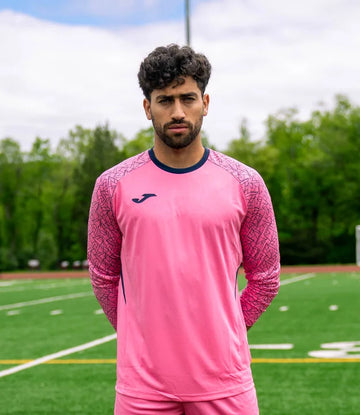
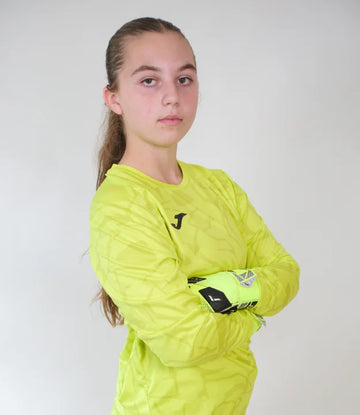
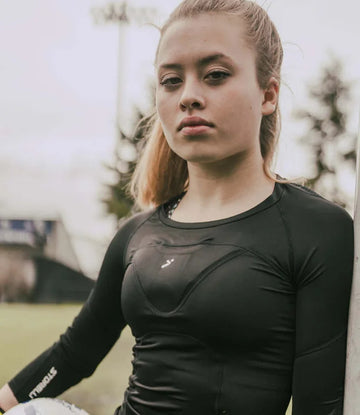
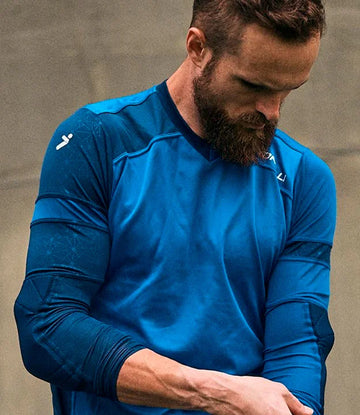
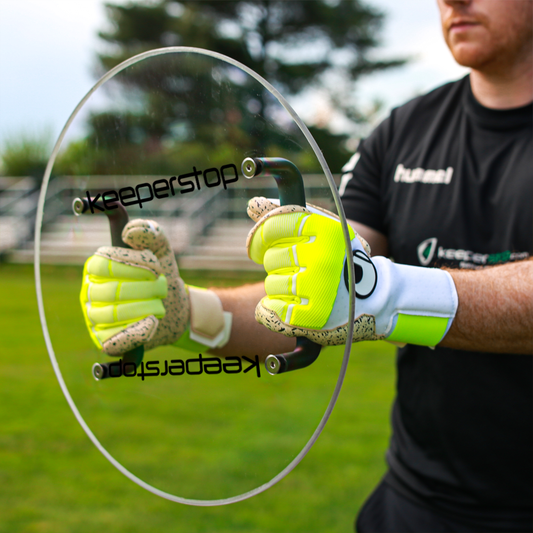
 Gloves
Gloves
 Jerseys
Jerseys
 Gear
Gear
 Brands
Brands
